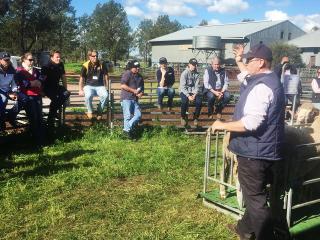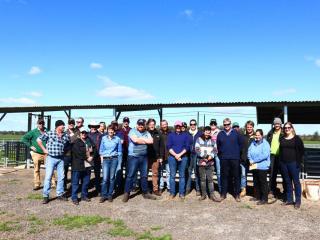A group of Western Australian sheep producers have returned from a New South Wales study tour enthusiastic and inspired about integrating more technology into their enterprises.
The study tour was organised by the Department of Agriculture and Food’s Sheep Industry Business Innovation project, made possible by Royalties for Regions.
The 19 delegates, members of the 100%+ Club, the department’s new On-farm Technology Pilot Group and AgConnect, were exposed to the latest advances in precision sheep management.
The delegation attended the bi-annual Lambex conference and met with leading producers, consultants and scientists to discuss the practical application of new technology on farm.
Department research officer John Paul Collins said a highlight of the tour was meeting consultant Anthony Shepherd from Sheepmatters advisory service, who specialises in assisting in the adoption of electronic identification technology, and some of his clients.
“Anthony was highly valued by his clients, who were using electronic identification technology extensively to generate a ‘resume’ of each animal from which to make informed decisions about their management and selection,” Mr Collins said.
“He advocated producers start small with a hand-held stick reader to become familiar with the technology and determine how it could be integrated on a larger scale before making an outlay for more expensive equipment.”
The group also visited Pooginook Merino stud, in south western NSW, where EID technology is used on all 6200 stud breeding ewes.
“Pooginook was a terrific example of large scale, high-tech precision sheep management,” Mr Collins said.
“The stud measures a huge range of traits that are used to calculate Australian Sheep Breeding Values as part of a high pressure selection process to generate significant breeding improvements and provide value to clients.”
The group also attended Charles Sturt University, where they were briefed about current research projects.
“One project investigated the difference in sex ratio of lambs produced by ewes fed Omega-3 or Omega-6 rich diets, which found feeding these enriched grains produced more female lambs,” Mr Collins said.
“We also heard about research into pasture types, worm control and embryo mortality, toured the NSW Department of Primary Industries feed laboratory and viewed its newly released drought feed calculator app.”
Since returning from NSW, Woodanilling sheep producer and On-Farm Technology Pilot Group member Richard Pickford, has made modifications to his sheep operation.
“I’ve made a few changes, including weaning earlier, applying extra selection pressure when classing my ewe hoggets and I plan to adjust my nutrition program to get my ewes to condition score three by joining,” Mr Pickford said.
“I’m also using ASBVs and researching the value of investing in electronic identification for my flock.”
Other members of the group have also reported plans to incorporate devices, such as sheep handlers and autodrafters into their businesses, while there has been considerable interest in apps to record sheep movements, husbandry and animal health treatments.
More information about the trip and the Sheep Industry Business Innovation project is available on the department website.


Media contacts: Jodie Thomson/Megan Broad, media liaison +61 (0)8 9368 3937
